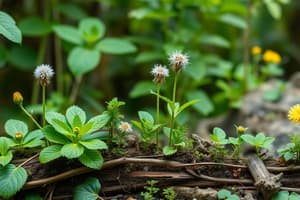Podcast
Questions and Answers
What is an ecosystem?
What is an ecosystem?
An ecosystem is defined as any unit that includes all the organisms in a given area interacting with the physical environment leading to a flow of energy.
Which of the following are components of an ecosystem?
Which of the following are components of an ecosystem?
- Biotic components
- Abiotic components
- Trophic levels
- All of the above (correct)
List the biotic components of an ecosystem.
List the biotic components of an ecosystem.
Producers, consumers, and decomposers.
Match the following types of organisms with their roles in an ecosystem:
Match the following types of organisms with their roles in an ecosystem:
Abiotic components include living organisms.
Abiotic components include living organisms.
Which of the following is NOT an abiotic component of an ecosystem?
Which of the following is NOT an abiotic component of an ecosystem?
What is the significance of the structure in an ecosystem?
What is the significance of the structure in an ecosystem?
What are the major types of ecosystems and biomes?
What are the major types of ecosystems and biomes?
Flashcards are hidden until you start studying
Study Notes
Ecosystem Overview
- An ecosystem integrates all living (biotic) and non-living (abiotic) factors of the environment.
- Defined by Sir Arthur G. Tansley in 1935 and further elaborated by Odum in 1974, focusing on energy flow, trophic structure, biodiversity, and material cycles.
Ecosystem Components
-
Biotic Components (Living)
- Producers (Autotrophs): Organisms that produce their own food, forming the base of the food web.
- Consumers (Heterotrophs): Organisms that rely on others for food, categorized into:
- Primary consumers: feed on producers.
- Secondary consumers: feed on primary consumers.
- Tertiary consumers: feed on secondary consumers.
- Decomposers (Detritivores): Break down dead organic matter and recycle nutrients back into the ecosystem.
-
Abiotic Components (Non-living)
- Include physical and chemical factors influencing the environment, such as:
- Climate
- Soil
- Water
- Light
- Wind
- Nutrients
- Topography
- Include physical and chemical factors influencing the environment, such as:
Ecosystem Structure and Function
- Refers to the spatial relationships of elements within an ecosystem.
- Vertical gradients in structure are influenced by abiotic factors like wind, light, humidity, and temperature.
- Stratification has been correlated with biodiversity:
- Birds are affected by foliage density.
- Bats are influenced by canopy openness.
- Small mammals relate to canopy cover and microhabitat distribution.
Energy Flow and Thermodynamics
- Energy flows through ecosystems, usually starting with sunlight captured by producers.
- Thermodynamics laws govern energy exchanges:
- Energy cannot be created or destroyed, only transformed.
- Energy transformations are not 100% efficient, leading to energy loss at each trophic level.
Food Chains and Food Webs
- Illustrate energy transfer within an ecosystem.
- Trophic levels denote the position of organisms in a food chain:
- Level 1: Producers
- Level 2: Primary consumers
- Level 3: Secondary consumers
- Level 4: Tertiary consumers
Ecosystem Types and Biomes
- Major types of ecosystems include forests, deserts, grasslands, aquatic systems, etc.
- Biomes are large ecological areas classified by distinct climates, flora, and fauna.
Studying That Suits You
Use AI to generate personalized quizzes and flashcards to suit your learning preferences.



